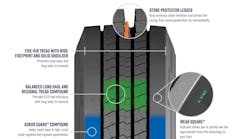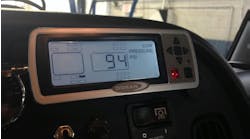Smooth, even treadwear is a thing of beauty. It all but ensures that the fleet will get the best cost per mile and is a good sign that the casing will be a prime candidate for retreading, which lowers life cycle cost.
Smooth and even treadwear also indicates that the maintenance department is doing an effective job, and the drivers are fulfilling their duty to perform pre- and post-trip inspections. When truck tires wear evenly, the credit is shared by a cast of trained professionals.
It starts with the proper inflation pressure. When I say proper inflation pressure, I'm not talking about what is molded on the sidewall. That is the minimum pressure for the maximum load. The proper inflation pressure is established by knowing the load and then inflating the tire to the best pressure that will carry the weight on the tire(s).
This isn't the type of decision that should be made without consulting the tire manufacturer, so fleets should take advantage of their engineering expertise and experience. In many cases, the best inflation pressure for the tire is less than what is molded on the sidewall.
If fleets follow the "load-to-inflation" model, then inflation pressure maintenance becomes even more important. Inflating to the pressure molded on the sidewall is technically overinflation in most instances, but it can also be viewed as insurance against underinflation. As a tire naturally loses 1-2 psi per month, a tire that is initially inflated to the sidewall pressure may not be underinflated for months when neglected.
Tire thumpers follow this procedure because it creates a larger margin of error, but the overinflation could have a negative effect on treadwear. It's a trade-off for the fleet in the sense that it may have to sacrifice some tread mileage to prevent underinflated tires and roadside breakdowns.
The next area to consider when preventing irregular treadwear is alignment. Front-end alignment is crucial for the best steer tire wear for obvious reasons. When the camber, caster, or toe is incorrect, treadwear will suffer. Likewise, tandem axles on a tractor that are not properly aligned can also result in irregular steer tire wear because the thrust angle is not perpendicular to the centerline of the vehicle.
On the trailer, improperly aligned axles result in "dog tracking"—the trailer travels at an angle to the tractor. Since the trailer tires are constantly being scrubbed at an angle, the resulting tire wear is often uneven and erratic.
Steer axle tires are probably the most sensitive when it comes to uneven treadwear for all of the previously mentioned reasons, but the silent killer is a non-concentrically seated bead.
A rim that is not perfectly centered on both beads of the tire will not maintain a uniform footprint when it completes a full revolution. Even the slightest variation can wear out a steer tire in half the time that it would normally take to wear out. The industry rule is that the distance between the edge of the rim and a molded rib on the lower sidewall should not vary by more than 2/32nds of an inch. That may work for drive and trailer positions, but in my opinion, there should be no variation in that distance on a steer tire. The reason for this condition is simply poor mounting procedures and can be avoided by following a few simple rules.
First of all, lubricate the rim and the beads with an approved rubber lubricant. Applying lube to the beads without lubricating the rim reduces the chance of concentrically seated beads because a lot of the lubricant will be rubbed off by the rim flange while the tire is mounted.
Next, the beads should be seated with the tire lying flat and the rim suspended. It's faster and easier to seat the beads with the tire in a vertical position, but it also increases the likelihood of a non-concentrically seated bead. Steer tires should always be seated horizontally on a lubricated rim without exception.
In most cases, irregular treadwear is preventable and linked to improper inflation pressure, improper alignment, or non-concentrically seated beads.


